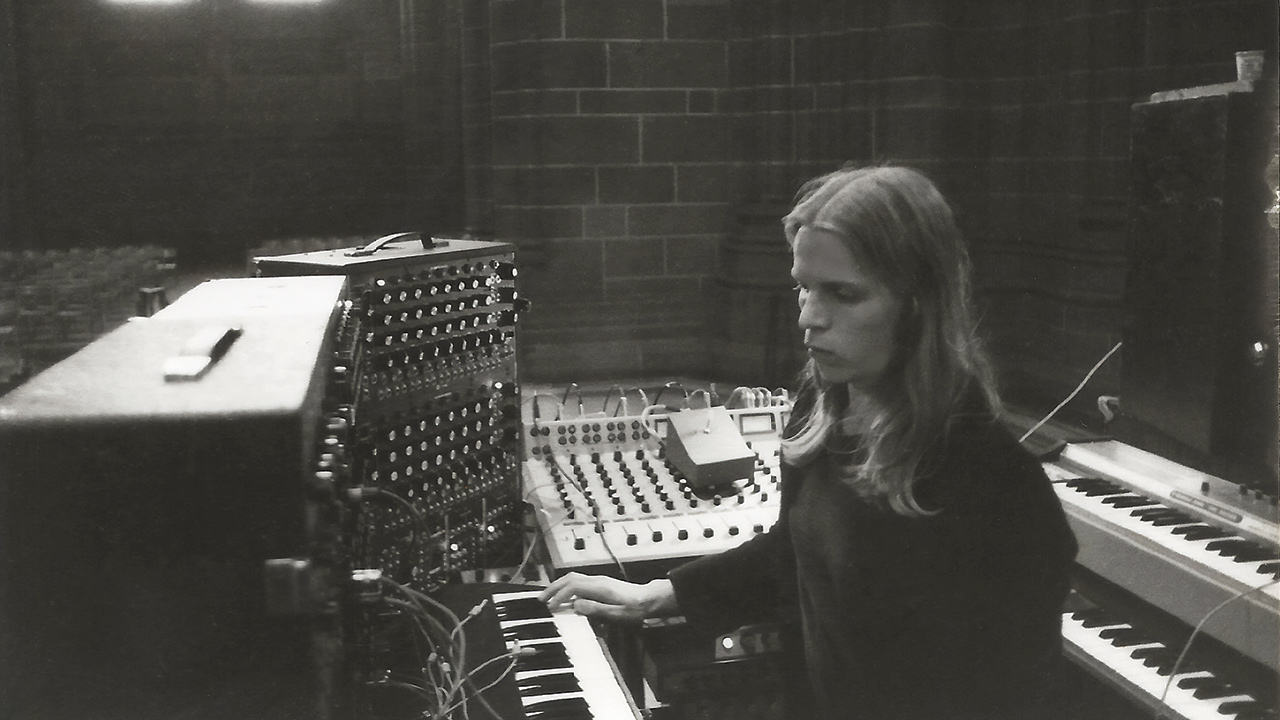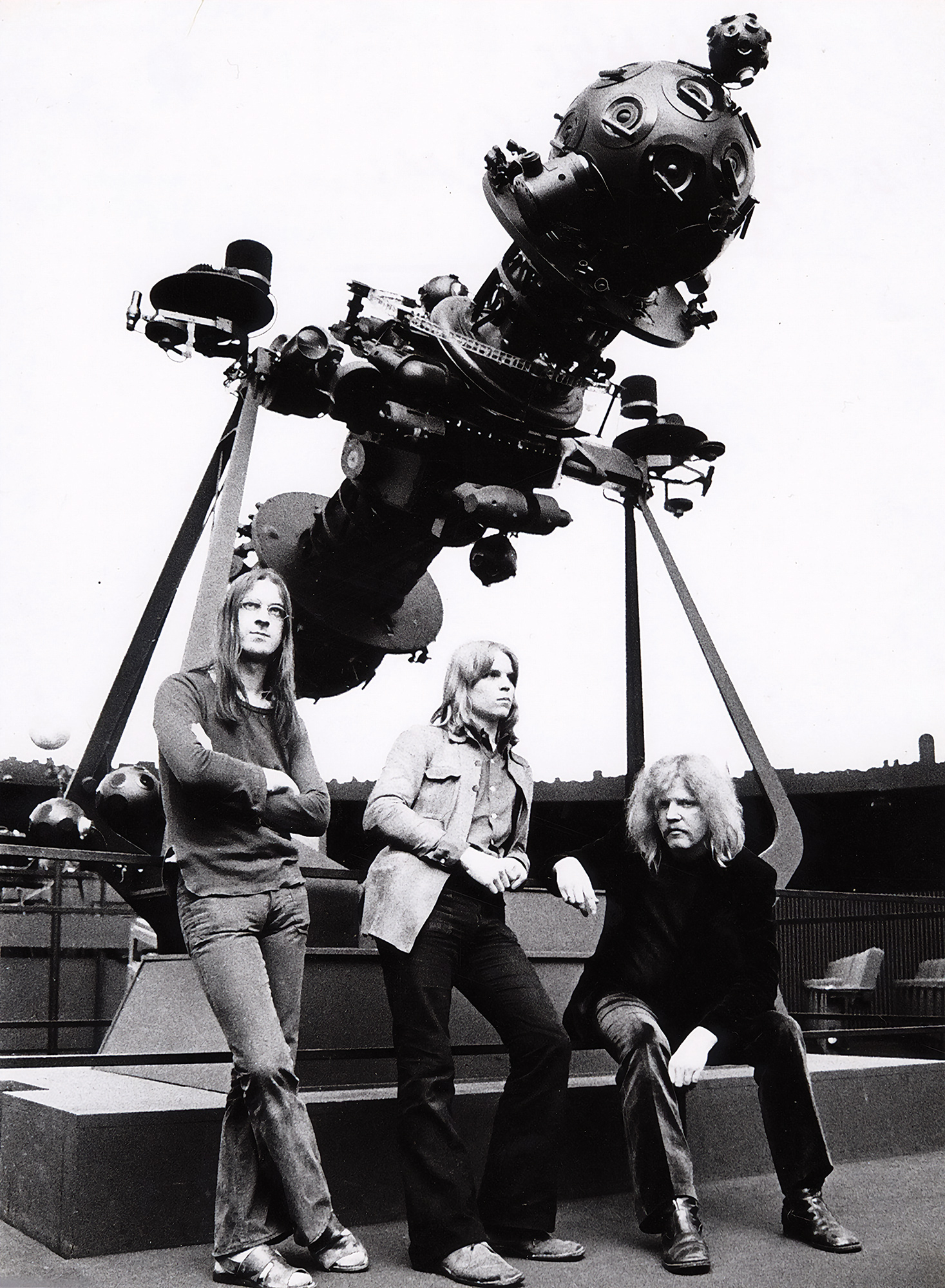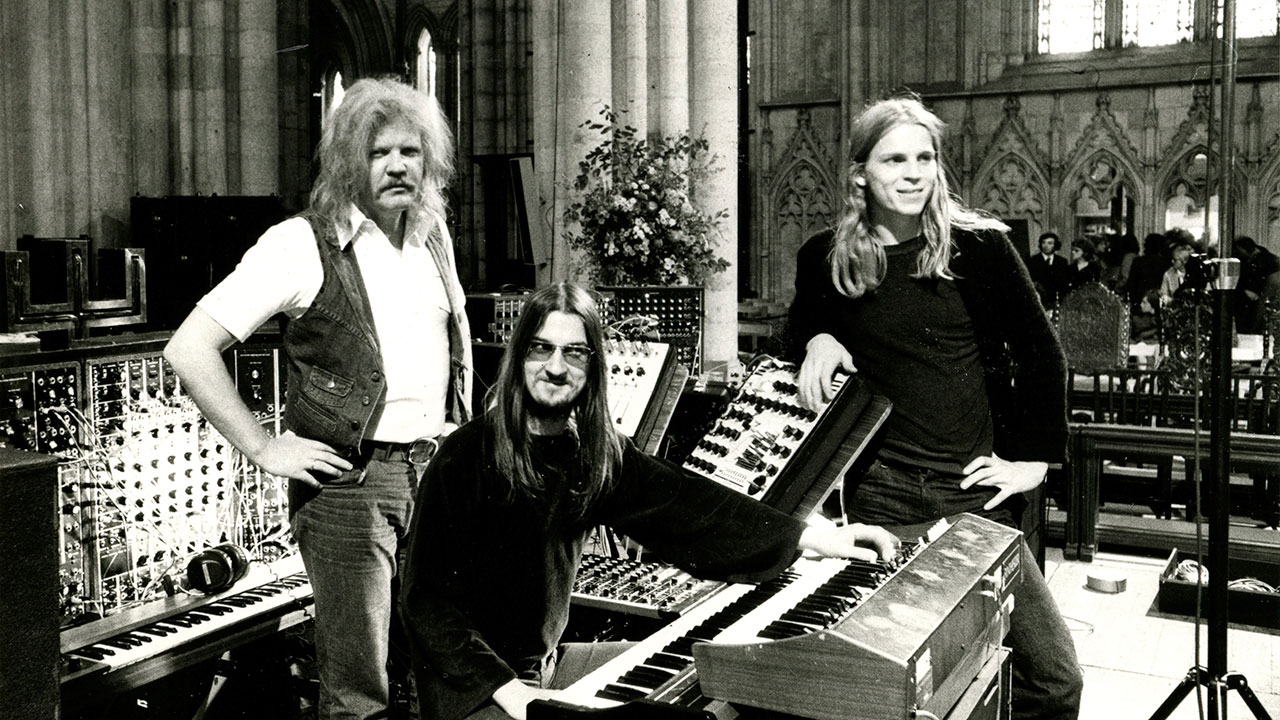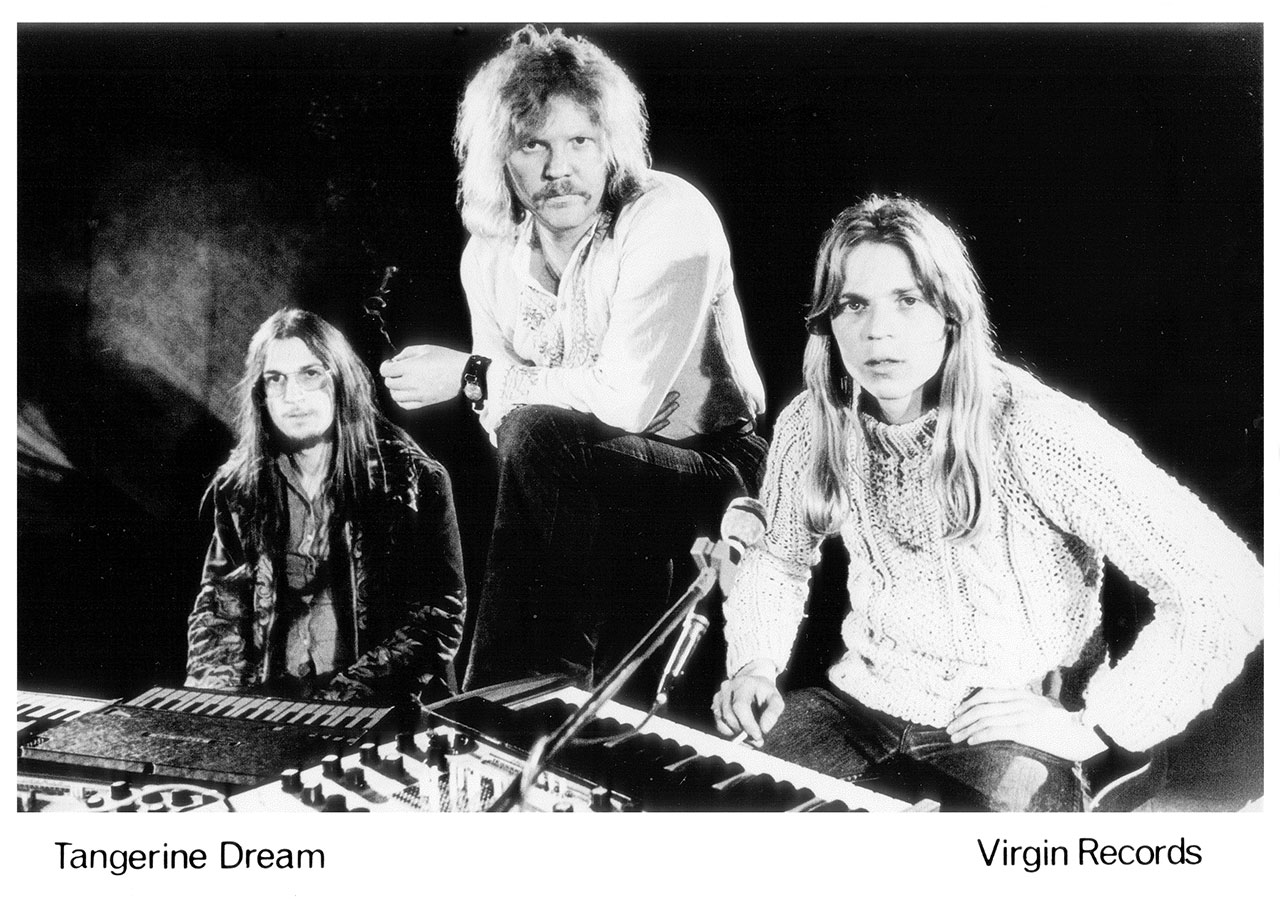Fifty years in the past, digital music acquired a brand new beat when Tangerine Dream launched Phaedra. The pioneering German group’s fifth studio album noticed the Berliners relocate to the English countryside, and its motorik grooves performed a key function in what was being outlined as krautrock. In early 2024, to rejoice the album’s fiftieth anniversary, Prog instructed the story behind one of many biggest experimental digital albums of all time, its legacy and the synthesiser that knowledgeable its sound.
November 1973. Frayed bell-bottoms had been the peak of style; Pink Floyd culminated their Darkish Facet Of The Moon tour and the Mariner 10 spacecraft blasted off on a mission to ship again the first-ever photographs of Mercury to an eagerly awaiting Earth. In the meantime, within the little Oxfordshire village of Shipton-on-Cherwell, three visionary musicians armed with cutting-edge expertise had been about to change the musical panorama endlessly. Edgar Froese, Peter Baumann and Christopher Franke – in any other case referred to as Tangerine Dream – flew from Berlin in Germany to Richard Branson’s The Manor to report an album that may change their lives and that of the many individuals who would hear it. It was a report that was to attain nice issues, blowing minds with its sheer invention and provoking a long time of digital music.
For Branson, it was a propitious time. Virgin Data was within the second 12 months of its existence and driving excessive on the outstanding success of Mike Oldfield’s Tubular Bells. The label’s mail order service was in full swing, offering followers in England with advance entry to the cream of American imports. By no means one to relaxation on his laurels, the entrepreneur had travelled in particular person to Germany to recruit his newest act.
By the point they signed to Virgin, Tangerine Dream had already launched 4 albums through German experimental label Ohr. They’d additionally undergone a number of adjustments in personnel, with founding member Edgar Froese the one fixed. For his or her earlier two long-players, nevertheless, Zeit (1972) and Atem (1973), they’d settled on what’s now thought-about their traditional line-up.
Froese was the group’s artistic powerhouse and polymath; an instinctive musician who’d additionally studied portray and sculpture on the Berlin Academy of Arts. On tour in Spain along with his first band, The Ones, Froese had carried out a particular live performance for the surrealist painter Salvador Dalí. It was a gathering that infused him with a ardour for experimentation. Returning to Germany, he fashioned Tangerine Dream in 1967 with a long-since forgotten line-up of Lanse Hapshash (drums), Kurt Herkenberg (bass), Volker Hombach (sax, violin, flute) and Charlie Prince on vocals. By the point Christopher Franke joined in 1971, after a stint as drummer for The Agitation – later renamed Agitation Free – Steve Jolliffe, Klaus Schulze and Conrad Schnitzler had all handed by the band’s ranks.
Peter Baumann additionally got here on board that 12 months, on the essential level when the band had been shifting from guitars to electronics. For Baumann, a profession in music was by no means deliberate.
“Oh, no, by no means,” he admits. “All the pieces that occurs in my life is an accident. And it was a quite simple story: I had a buddy at school, and we had been simply chatting. He stated, ‘I’m enjoying in a band, why don’t you come alongside and pay attention?’ So I went. They’d a bass participant, guitar participant, vocalist and drummer, however no keyboard. So I stated, ‘Why don’t I am going on keyboards and be a part of you?’ And that was it.”
Primarily a covers band, this was a very good expertise for Baumann, however not fulfilling. It was one other accident of destiny, an opportunity assembly, that
initially led to his involvement with Tangerine Dream.
“I used to be at a live performance – Emerson, Lake & Palmer,” he remembers. “They began late, so I started to speak to the parents behind me. There was a man with lengthy, darkish hair named Christopher. We had been chatting about what we had been doing. He stated he performed in a band. I stated, ‘I do some experiments with music as nicely.’”
Bonding over a shared love of instrumental data, the 2 exchanged particulars and, per week later, Baumann obtained a notice from Franke urging him to get in contact as they had been searching for a brand new keyboard participant.
“So I known as up,” remembers Baumann, “and a couple of week later, they invited me to carry my keyboard and meet them at a rehearsal room. The remaining is historical past.”
Over their following two albums, Zeit and Atem, Tangerine Dream set about exploring new sounds.
“The music was evolving, intuitively,” says Baumann. “You’re at all times making an attempt new issues and also you say, ‘Hey, that appears to work’, however we by no means actually mentioned the music a lot. It was extra like: have a very good joint after which begin enjoying.”

With Phaedra, nevertheless, that modified.
“The main distinction was that it was the primary report the place we had
a Moog synthesiser,” remembers Baumann. “That was very distinctive on the time, and it actually set the flavour for the primary piece.”
The synthesiser in query got here to the group through an uncommon path. Someday in 1969, The Rolling Stones had bought a whole modular system from Moog, one of many very first commercially accessible. The Stones’ experiments with the nascent expertise finally led nowhere. Dissatisfied, they offered their gear to the Hansa Studio in Berlin, an institution that may later turn into well-known by its use by David Bowie, Iggy Pop and others. Again in 1973, Hansa accepted a suggestion for the Stones’ previous Moog from Tangerine Dream’s Christopher Franke. A discount at solely $15,000 – an equal of about £90,000 in right this moment’s cash.
Franke paid for the Moog utilizing the band’s advance from Virgin. Baumann remembers how the group’s contract with Branson’s firm took place.
“He [Branson] was searching for bands. And I believe it was Simon Draper [Virgin Records co-founder] who instructed him there have been a couple of bands in Germany – Faust, Can and Tangerine Dream – that he ought to take a look at. So he got here to Berlin. We acquired alongside famously, and he made us a suggestion.”
Quick-forward to November, 1973 when the group decamped to Oxfordshire and arrange residence in The Manor.
“We recorded fairly nicely in Germany,” says Baumann, “however The Manor studio was a complete completely different ball sport. We had a very nice
16-track machine and actually good outboard gear. It was a ravishing facility. For 3 weeks we acquired in there and recorded Phaedra.”
It was a report that grew organically.
“We by no means had any clear thought of what we had been going to do,” stresses Baumann. “There was one commonality – that’s we’d begin very, very merely and see what occurred. Even in dwell concert events we began from one notice after which developed from that one notice. That was the one factor that we ever mentioned.”
Tangerine Dream’s influences on the time got here largely from fellow
sonic experimenters.
“We listened to a number of instrumental music,” remembers Baumann. “Stockhausen and Ligeti – a number of classical composers who did very experimental issues.”
Born in 1928, German composer Karlheinz Stockhausen was an early innovator in digital music. Almost 20 years earlier than Phaedra was realised, his pioneering Gesang Der Jünglinge had combined human voices with electronically generated pulses, tones and white noise. Across the similar time, Transylvania-born György Ligeti had begun utilising micropolyphony – dense traces of sound transferring at various tempos and rhythms.
“From the favored bands,” says Baumann, “we listened to Pink Floyd’s Ummagumma after which The Darkish Facet Of The Moon. The instrumental sections – they had been our favourites.”

The genius of Froese, Baumann and Franke, primarily based largely on intuition, lay in combining these disparate components into a completely authentic mannequin. Even throughout recording, that they had no thought how Phaedra would sound in its last type.
“We recorded fairly a bit,” explains Baumann, “and a number of it was junk that we threw out. However clearly [the title track] labored very nicely, and so we refined it just a little bit within the studio. It’s not a dwell state of affairs, so within the studio we might do some overdubs.”
It was a strategy of going backwards and forwards between the three.
“We by no means mentioned the music; we’d simply say, ‘I prefer it’, or ‘I don’t like that.’ So, you already know, it was a collaboration on many various ranges, and it was extraordinarily intuitive. There was, particularly with Phaedra, by no means any combating or disagreements or something like that. It was actually a really instinctual and homogeneous collaboration.”
In line with Baumann, the novel setting they discovered themselves recording in helped to form the music.
“In hindsight, it was a significantly better ambiance. We loved being within the nation; The Manor was a terrific facility and we cherished being there. And we’d by no means earlier than labored three weeks in a row. Though I used to be, on the time, 19 or 20 years previous. I wasn’t paying a lot consideration to the larger image.”
Even when issues had been going nicely, the band had no sense that the Phaedra venture would quantity to their largest success so far.
“We simply knew that we preferred it,” says Baumann. “I imply, there was actually no comparability. It was so distinctive. No person else was doing something like that. We simply loved it. And we thought it was cool. Very cool.”
The prolonged classes weren’t with out their challenges. Talking in an interview for Mark Prendergast’s complete examine of digital music, The Ambient Century (2000), Edgar Froese confirmed:
“Technically, all the pieces that would go fallacious did go fallacious. The tape machine broke down, there have been repeated mixing console failures, and the audio system had been broken due to the unusually low frequencies of the bass notes.”
Frequent energy cuts added to the band’s woes. A miners’ strike was in full swing and business customers of electrical energy had been prohibited at sure occasions. To additional complicate issues, incessant rain discovered its means in by the roof of the previous constructing, resulting in a mass scramble to guard valuable devices and gear by binding it in plastic sheeting. A specific low level occurred when Froese witnessed the Manor’s resident Irish wolfhound amble in, increase its leg, and urinate in opposition to the band’s Mellotron.
Regardless of these travails, workers at The Manor did their finest to keep up a very good ambiance, and step by step Phaedra took form. The band labored lengthy days, starting mid-morning and toiling on into the small hours. With no presets or writeable reminiscence, organising the Moog alone proved to be time-intensive. The outcomes, although, had been price it. The synthesiser’s driving arpeggiated bass line supplied a shocking bedrock for the group to construct on, utilizing Mellotron, guitars and electrical piano to assemble a hypnotic, layered soundscape. A quirk of the brand new gear was its excessive sensitivity to warmth: when the Moog warmed up, it additionally went out of tune. The trio used this to their benefit, letting the Moog have its means and incorporating the outcomes into the title monitor.

The completed album was launched within the UK on the February, 20 1974 and, to the common listener, Phaedra will need to have seemed like a broadcast from an alien planet. The title monitor alone proved a revelation. Occupying everything of facet one, Phaedra itself builds from an uneasy synth effervescent, step by step coalescing right into a hypnotic, polyrhythmic entity, shifting like a kaleidoscope by multicoloured clouds of Mellotron tones. The three tracks comprising facet two, Mysterious Semblence At The Strand Of Nightmares, Actions Of A Visionary and Sequent ‘C’ type one thing of area rock symphony, taking the listener on a beguiling journey to unusual, distant galaxies. Phaedra supplied music that seeped into the soul. Nothing fairly prefer it had invaded the UK’s airwaves and bedrooms earlier than.
Not surprisingly, some responses from critics had been brazenly hostile, together with an notorious diatribe from Melody Maker’s Steve Lake, who described the report as “gutless and spineless, devoid of inspiration” Regardless of such vitriol and spurred on by publicity from far-sighted radio DJs similar to John Peel, Phaedra step by step grew into one thing of a phenomenon. In a beautiful little bit of poetic justice, it broke Melody Maker’s personal Prime 10. Baumann was as stunned as anybody by the report’s success.
“It was very humorous – per week or two after it got here out, I used to be in Italy with
a girlfriend and I acquired a telegram from Richard [Branson] saying, ‘You must come to London, your report is within the Prime 10.’ I believed, what’s he speaking about? I had no thought, so I known as him, and he stated, ‘No, no, Peter, it’s within the Melody Maker Prime 10.’ And so I went to London to do a ton of interviews.”
It was an astonishing feat for such a radical report.
“We had been a very experimental band,” says Baumann. “We weren’t rock, we weren’t pop, and we performed for comparatively small audiences in Germany. We didn’t even promote a number of data in Germany. Atem and Zeit offered possibly a few 1000’s, possibly 10,000 – we by no means offered a lot at first. So, I had no expectations. I used to be completely stunned and, you already know, it was a life-changing occasion.”
Phaedra hit No.15 on the UK album chart, proving the critics fallacious and opening the floodgates to a surge of curiosity within the new music coming from throughout the English Channel. Kraftwerk’s Autobahn, launched within the UK a couple of months later, reached No.4 on the UK album charts and listeners quickly sought out bold sounds from different radical German teams similar to Faust, Can and Amon Düül II.
Phaedra’s success propelled Tangerine Dream to a brand new stage of movie star.
“I believe we took it just about in our stride,” displays Baumann. “The primary time it hit me was after we did a few concert events after the album acquired profitable: the primary was in London [at Victoria Palace Theatre on June 16, 1974]. There have been 1000’s of individuals there and that was type of gorgeous. It simply hit me: oh my God, there are literally folks liking it!”
It was the primary time that the band encountered their UK followers head to head. They knew that Phaedra was promoting nicely, however experiencing the adoration shut up was a shock.
“In a dwell setting,” says Baumann, “it’s actually a totally completely different ball sport. And it actually hits you that 1000’s of persons are spending their money and time to come back to listen to you. That was distinctive.”
For him, the album was a private turning level, one the place he started to grasp {that a} long-time profession in music was attainable.
“I didn’t plan something,” he muses. “I simply did what I loved doing and so they [Froese and Franke] appeared like a few cool folks to journey with, hang around with, and make music with. And, you already know, there was no means that I might have deliberate making a residing off of it.”
After Phaedra, although, music turned a full-time job.
“You compromise in,” says Baumann, “and then you definitely do the following report, and also you do a tour right here and a tour there. Then we went to America and did tons of interviews. It turned a life-style.”
The three younger musicians tailored nicely, their pure level-headedness a strong anchor in opposition to the strains and excesses of the enterprise.
“It wasn’t that troublesome,” Baumann remembers. “You already know, Tangerine Dream was not about personalities. None of us was a star or a particular particular person. It was at all times the music that was entrance and centre. We had some groupies and stuff, however it was by no means as wild and loopy as with among the rock bands.”

Phaedra sits proud among the many many positive entries in Tangerine Dream’s in depth discography, and its affect has by no means dimmed.
“I believe one of many causes,” says Baumann, “is that it was one of many first digital data and it turned type of a landmark for lots of other people. The distinction with Phaedra is that it’s extra like an inside expertise relatively than an exterior expertise, the place folks soar up and down, screaming, at a rock live performance. It has a really completely different ambiance that lends itself very nicely for folks to pay attention at residence with headphones.”
It’s an album tied to the distinctiveness of the time of its genesis. The novelty of the expertise and the set-up of the music enterprise created excellent circumstances for such an album to seep into the general public consciousness.
“Yeah, it’s a really completely different ball sport now,” Baumann displays, “and in addition the distribution could be very completely different. All the pieces is rather more fast-paced. When you would launch a report like Phaedra right this moment, it could not be seen, or little or no.”
The ever-present entry to music, he argues, has to some extent lessened its particular aura.
“Again then there have been no computer systems and music was a way more necessary a part of folks’s lives than right this moment.”
Within the Seventies, particularly in Germany, experimentation inside common music was rife. Bands had been transferring away from the ever present three-minute verse-chorus track with a conventional drums, guitar and bass set-up in direction of a extra inward-looking sound.
“I believe it’s the German mentality, you already know,” Baumann displays. “Through the years there have been very, only a few actual rock bands, you already know. They’d their pop music, however testosterone-driven rock music, that simply was not a German factor. You had the Scorpions on the time, and possibly one or two different bands, however I believe Germans, they dwell extra of their heads than of their guts.”
Phaedra is a landmark of such cerebral, transformative music and, half a century on, it continues to resonate. And Baumann continues to be stunned by its enduring recognition.
“Right here we’re 50 years later doing an interview. And yeah, I didn’t suppose that it could final that lengthy,” he admits.
As with every long-lived band, Tangerine Dream have drifted out and in of prime focus however have by no means ceased to be related.
“There are phases when it’s extra noticeable,” he agrees, “after which much less – it goes by waves.”
For Baumann, it’s been a protracted journey with loads of excessive factors. “Enjoying the Royal Albert Corridor [in April 1975] was clearly one thing you don’t overlook,” he says. “Additionally Reims Cathedral [France, 1974] and New York Metropolis [on several occasions].”
Of enjoying dwell, he admits, “It’s like intercourse. Typically it’s one of the best factor on this planet. And generally it’s simply one thing that it’s important to do. However it’s at all times higher doing it than not!”
And was Phaedra the album that began all of it?
“I don’t take heed to it fairly often,” he confesses, “however once I do, you already know, it’s actually timeless. It was at all times in its personal world; it didn’t match into any class.”
Legions of followers would absolutely rush to agree.
